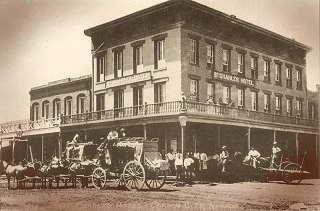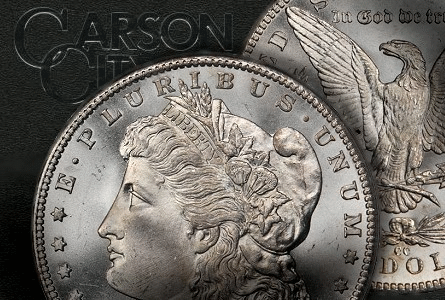By Ron Drzewucki – Modern Coin Wholesale …..
Five branch mints were involved in the production of Morgan silver dollars: Philadelphia, Carson City, San Francisco, New Orleans and, at the very end of its run, Denver. To a Morgan dollar collector, coins from each mint have different “personalities” – San Francisco represented the cutting edge of coining technology and produced stronger strikes; coins from New Orleans are common, flatly struck and heavily-circulated, etc. You more or less know what to expect, sight unseen.
But none of the other mints comes close to the allure of Carson City.
The City
Carson City, Nevada was founded in 1858 by settlers in Utah territory looking to establish a capital for a new territory free of Mormon control. It was named in honor of legendary frontiersman Kit Carson, who had been among the first Anglo-Americans to explore the area in the early 1840s.
 Over the same span of time, gold and silver were discovered in the vicinity. In 1859, Henry Comstock went public with his claim to what is famously known as the Comstock Lode. It’s hard to overstate the importance of this discovery for the region’s history. As a consequence, the Territory of Nevada was established in 1861, with statehood following in 1864. Since it was one of two states to join the union during the Civil War (West Virginia being the other), Nevada gained the nickname the “Battle Born State”.
Over the same span of time, gold and silver were discovered in the vicinity. In 1859, Henry Comstock went public with his claim to what is famously known as the Comstock Lode. It’s hard to overstate the importance of this discovery for the region’s history. As a consequence, the Territory of Nevada was established in 1861, with statehood following in 1864. Since it was one of two states to join the union during the Civil War (West Virginia being the other), Nevada gained the nickname the “Battle Born State”.
(In case you’re wondering, “Nevada” is Spanish for “snowy” or “snow-covered”.)
As another consequence of the find, Carson City grew into a major Nevada city and became the territorial and state capital.
The Mint
The Carson City Mint was built in 1866, the Civil War having delayed its construction for three years.
 Being in such close proximity to the Comstock Lode–the largest find of its kind since the California Gold Rush–Carson City was well-suited to take advantage of the prodigious precious metal output of the region. Abraham Curry, the founder of Carson City and one of the original settlers, served as the mint’s first superintendent when it opened in 1869.
Being in such close proximity to the Comstock Lode–the largest find of its kind since the California Gold Rush–Carson City was well-suited to take advantage of the prodigious precious metal output of the region. Abraham Curry, the founder of Carson City and one of the original settlers, served as the mint’s first superintendent when it opened in 1869.
Coining operations began in 1870. A Seated Liberty silver dollar was the first coin struck at the facility. Besides the Seated Liberty dollar, Carson City produced Seated Liberty quarters, half dollars, and dimes. A silver 20-cent piece was minted there for a year. Morgan and Trade dollars were also produced.
Gold half eagles ($5), eagles ($10) and double eagles ($20) were minted there from the start.
1876 saw record output from the Comstock Lode and so the nation’s centennial is also the high water mark for Carson City mintages.
Production of all denominations–silver and gold–stopped in 1885, when Superintendent James Crawford died. Politics in Washington prevented the appointment of another superintendent, so the mint was offline until Democrat Grover Cleveland left office and Republican Benjamin Harrison became president in 1889. The mint remained active until 1893, when Harrison left office and Cleveland was once again president.
The building was home to the United States Assay Office for Gold and Silver from 1895 to 1933, when President Franklin Delano Roosevelt issued a series of executive orders banning the private ownership of gold and removing all gold coins and certificates from circulation.
Today, the old Carson City Mint is home to a branch of the Nevada State Museum. Coin Press No. 1 still resides in the building and is used on special occasions to produce commemorative tokens and medallions, meaning the “CC” mintmark is alive and well in the field of American exonumia.
The Coin
But of all the coins minted in Carson City, it is the Morgan dollar that has exerted the greatest sway over generations of collectors.
Powerful western mining interests were enraged by the so-called “Crime of ‘73”–perhaps the most notorious of the Coinage Acts of American History. The Coinage Act of 1873 effectively demonetized silver by ending production of the Seated Liberty silver dollar (along with the silver half dime and three-cent piece) and ending fixed pricing for silver the government bought.
This meant no more corporate welfare for the silver mines, who were forced to–*gasp*–abide by world silver market prices.
Luckily for western mining concerns, 1873 also saw a major economic crisis, which brought many populists over to the silverite cause. By 1878, these interests had managed to get the Bland-Allison Act passed, a law that required the Treasury Department to buy large amounts of silver annually and to mint a re-monetized silver dollar.
Thus the Morgan dollar was born.
Unfortunately, there must’ve been some wisdom behind the provisions of the “Crime of ‘73”, because the general public had no real use for the new coin. Bags upon bags of Morgan dollars began to accumulate in Treasury vaults around the country.
Yet it continued to be minted. The last Carson City Morgans were issued in 1893, and the entire series continued until 1904, when the silver reserves purchased under another law, the Sherman Silver Purchase Act of 1890 (which replaced Bland-Allison), were used up.
 Many Morgans were melted in 1918 because of the Pittman Act, a wartime law meant to shore up silver bullion supplies for our ally Great Britain. This resulted in an apparent scarcity that fueled collector interest–and Carson City Morgans were among the rarest.
Many Morgans were melted in 1918 because of the Pittman Act, a wartime law meant to shore up silver bullion supplies for our ally Great Britain. This resulted in an apparent scarcity that fueled collector interest–and Carson City Morgans were among the rarest.
Or so it seemed.
In the 1960s, the Treasury suddenly discovered the bounty of Morgan dollars it had secreted away in its basements and vaults. Some collectors then bought “rare” Morgans directly from the Treasury Department, but once silver certificates could no longer be exchanged for silver dollars, the spigot was turned off.
Then came 1972 and the first Treasury/GSA sale of Morgan dollar coins. It turned out that the Treasury Department was sitting on almost three million Carson City Morgans. There was some consternation among collectors, used to decades of scarcity, that the market for Carson City Morgan dollars would never recover from the dispersal of such a hoard. Some even encouraged people NOT to buy them…
Yeah, never tell coin collectors not to do something.
Over time, however, the market has proven the naysayers wrong. They underestimated the mainstream, non-numismatic appeal of Morgan dollars (a lesson not lost on the Mint in later decades, as they rolled out such programs as the 50 State Quarter series). Carson City specimens deemed Uncirculated by the GSA have not only recovered their old prices but improved upon them.
There’s just something about a Carson City Morgan dollar.
The Allure
The Morgan dollar is a coin strongly associated with the “Old West”–in no small part thanks to the Carson City issues. The people who bought Morgan dollars during the GSA sales of the 1970s were the same people who, as children, could spend a dime at the local cinema and watch John Wayne and Gary Cooper on the big screen. The success of those sales did much to grow the hobby as a whole into what it is now, so it’s not much of a stretch to suggest that nostalgia for the American West and the larger-than-life personas that inhabited it is one of the great driving forces behind the entire hobby.
Americans love American history. It’s the common factor behind the success of Ken Burns, ancestry.com and coin collecting itself. A Carson City Morgan dollar encompasses it all.
-Ron




